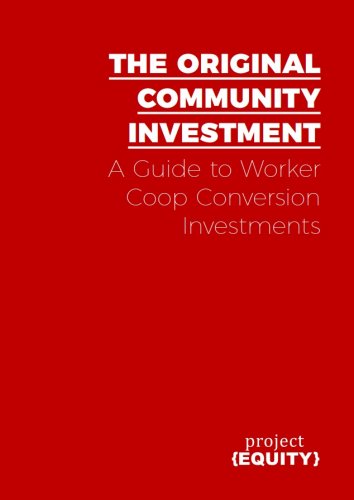While the impact investing field has taken off in recent years and has influenced mainstream banking priorities, worker cooperatives are not yet a viable option for a typical impact investor interested in ‘investing with purpose.’ In other words, while assets under management in the United States’ impact investment space have grown to $15.2B, only a tiny portion of those investments are going into workerowned cooperative businesses. What would it take for an investor to be able to easily target part of their investment portfolio to worker-owned cooperatives, to ‘mainstream’ the practice of investing in worker cooperatives?
Download The Original Community Investment: A guide to worker coop conversion investments
Worker cooperatives provide a myriad of benefits. For worker-owners, benefits include better paying jobs, asset and skill building, and enhanced control over their work lives. For businesses, benefits include reduced employee turnover and increased profitability and longevity. For society more broadly, worker cooperatives foster social innovation, expand access to business ownership, and train people in democratic practices. Worker coops are also positively correlated with many health and other social benefits. However, in the U.S. today, there are only an estimated 3-400 worker coops.
Converting existing business to worker coops through a leveraged employee buy-out—with the support of appropriate capital—has the biggest potential to significantly grow the worker coop sector in the U.S., especially by tapping the baby boomer retirement wave, dubbed the ‘Silver Tsunami.’ There will be a dramatic shift in the landscape of local business ownership as baby boomers retire. It is estimated that boomers own between nearly half and two-thirds of privately held businesses with employees—or four million companies, leading to forecasts that “trillions of dollars of value are going to change hands in the next 10 to 20 years.
Table of Contents
INTRODUCTION
WORKER COOP CONVERSION INVESTING 101: Frequently Asked Questions
WHAT IS A WORKER-OWNED COOPERATIVE?
How are worker coops managed?
How are profits shared?
How does an Internal Capital Account work?
How are financial statements different?
WHAT IS A WORKER COOPERATIVE CONVERSION?
Why do business owners decide to convert to a worker coop?
What is the difference between an ESOP and a worker cooperative?
What are the steps in a coop conversion?
What supports help make coop conversions successful?
WHAT OPTIONS EXIST FOR INVESTING IN WORKER COOPS?
Member equity voting shares
Private offering of Class B preferred stock
Investment crowdfunding
Indirect investments from loan and investment funds
WHAT ARE OTHER INVESTMENT CONSIDERATIONS?
What role can loan guarantees play?
How are working capital and growth capital needs taken into account?
Who structures or signs for an investment on behalf of the coop?
CURRENT STATE SNAPSHOT
CONCLUSION
APPENDICES
APPENDIX A: Cooperative loan funds
APPENDIX B: Current and potential sources of capital for worker coops
APPENDIX C: Interviewees and reviewers
APPENDIX D: Sample term sheets
Format





